
|
|
|
|
|
|
|
|
|
|
We live on the land of the Wurundjeri People
We acknowledge the traditional owners of this land
and the fact that Indigenous sovereignty has never been ceded.
Nillumbik Reconciliation Group is a volunteer-based, non-profit incorporated group committed to furthering the process of reconciliation with Australia's Indigenous peoples – the first Australians. Based in the Shire of Nillumbik, which includes the Melbourne suburb of Eltham and surrounding areas, the Group aims to cultivate and promote the issues of reconciliation in our local region. Click on the links down the left hand side of the page to find out more.
Original website design: Mark Lowrie. NRG logo design: Elizabeth Savage Kooroonya
Last updated: 21st June, 2017
© Copyright 2000 - 2017 Nillumbik Reconciliation Group Inc. Nillumbik Reconciliation Group does not object to its articles being reprinted provided they are not edited and the source is properly acknowledged. However, please note that this website may also contain articles and/or images copyright to other organisations or individuals.
____________________________________________________________________
GAWA WURUNDJERI RESOURCE TRAIL
____________________________________________________________________

You can download a copy of this flyer here
____________________________________________________________________
ULURU STATEMENT FROM THE HEART
(You can download a pdf of the Statement here)
We, gathered at the 2017 National Constitutional Convention, coming from all points of the southern sky, make this statement from the heart:
Our Aboriginal and Torres Strait Islander tribes were the first sovereign Nations of the Australian continent and its adjacent islands, and possessed it under our own laws and customs. This our ancestors did, according to the reckoning of our culture, from the Creation, according to the common law from ‘time immemorial’, and according to science more than 60,000 years ago.
This sovereignty is a spiritual notion: the ancestral tie between the land, or ‘mother nature’, and the Aboriginal and Torres Strait Islander peoples who were born therefrom, remain attached thereto, and must one day return thither to be united with our ancestors. This link is the basis of the ownership of the soil, or better, of sovereignty. It has never been ceded or extinguished, and co-exists with the sovereignty of the Crown.
How could it be otherwise? That peoples possessed a land for sixty millennia and this sacred link disappears from world history in merely the last two hundred years?
With substantive constitutional change and structural reform, we believe this ancient
sovereignty can shine through as a fuller expression of Australia’s nationhood.
Proportionally, we are the most incarcerated people on the planet. We are not an innately criminal people. Our children are aliened from their families at unprecedented rates. This cannot be because we have no love for them. And our youth languish in detention in obscene numbers. They should be our hope for the future.
These dimensions of our crisis tell plainly the structural nature of our problem. This is the torment of our powerlessness.
We seek constitutional reforms to empower our people and take a rightful place in our own country. When we have power over our destiny our children will flourish. They will walk in two worlds and their culture will be a gift to their country.
We call for the establishment of a First Nations Voice enshrined in the Constitution.
Makarrata is the culmination of our agenda: the coming together after a struggle. It captures our aspirations for a fair and truthful relationship with the people of Australia and a better future for our children based on justice and self-determination.
We seek a Makarrata Commission to supervise a process of agreement-making between governments and First Nations and truth-telling about our history.
In 1967 we were counted, in 2017 we seek to be heard. We leave base camp and start our trek across this vast country. We invite you to walk with us in a movement of the Australian people for a better future.
REFERENDUM AND MABO
Speech by Jan Aitken at a Panton Hill Reserve event, with Nillumbik Shire Council, on Sunday 28 May 2017
(see event flyer below)
I voted in the referendum fifty years ago on 27 May 1967. I thought I was giving Aboriginal people full recognition and a humanity of which they had been deprived. By me, by our nation. I did not realise what a long journey we were all embarking on. Being counted in the census was a beginning, as was the other change to the constitution – that of removing clauses which actually disallowed the Federal Government’s power to make laws for Aboriginal people. Now Aboriginal people were included as members of the population of our nation. “Count us together. Make us one people”
What contributed to the overwhelming yes vote in this referendum? Bipartisan support. A huge effort on the part of black and white leaders working together over the ten previous years – support from people like Pastor Sir Doug Nicholls, Faith Bandler, Jessie Street, Evelyn Scott and many others. And interestingly, the No side of the argument was never presented as an option. 90.99% voted Yes.
However, these changes did not guarantee equality. The government could make laws but was not constrained to make equality a character of legislation.
Winning the referendum was the First Step. The government was in no hurry to legislate for education, housing, wages, trade training, land grants etc.
In 1972-4 Aboriginal activists established the Tent Embassy in Canberra and began to speak out in urgent tones about the absence of rights, the loss of land, the Stolen Generations. The Tent Embassy was a powerful symbol. The original owners of the land, now landless, acted as foreigners in their own country – with an embassy. It was a response to Mr Justice Blackburn’s ruling in 1971 that the Yirrkala people in Arnhemland had no right to proprietorship of their land under British law.
Banners:
If you can’t let me live Aboriginal why preach Democracy?
White invaders you are living on stolen land.
We wuz robbed. Land rights now.
No Apartheid for Aborigines
In 1975 Gough Whitlam heard the call for land rights, and in response to the Wave Hill Walk-off he travelled to Wattie Creek and poured soil into the hands of Vincent Lingari, solemnly promising that his land will be the possession of the Gurindgi people.
Eddie Koiki Mabo, a TSI man from Mer Island in the Torres Strait, was working as a gardener at the James Cook University, Townsville in 1974. He was active in Aboriginal rights there – he had helped found the Health Service, and was known as an outspoken supporter for his people. He met Henry Reynolds, a young academic historian who was discovering Aboriginal history. It had never been included in history studies at schools or universities.. Through their conversations Eddie Mabo realised that the land he thought was his, on his island, was now owned by the Commonwealth of Australia. And he decided to get it back and own it in his own historical right. So began a long period of legal preparation with the legal contests and claims beginning in 1982. Land bilong Islanders.
Ten years later, after many legal battles with the Queensland and Federal governments, Eddie died on 21/1/92, six months before the High Court wiped out two assumptions on which the ownership of Australian land by the Commonwealth rested. The first assumption was that A&TSI people had no concept of land ownership in 1788 when Australia was taken; the second, that British sovereignty abolished any existing right that may have existed.
The Meriam people of the Torres Strait proved that Meriam custom and laws, fundamental to their traditional system of ownership, underpinned traditional rights and obligations. They owned their land.
The High Court found that our continent was not Terra Nullius: Land belonging to no one; that Indigenous people had lived here for thousands of years and enjoyed the rights of the land with their own laws and customs; that Australia was dispossessed, piece by piece, as the colony grew; that dispossession underwrote the development of Australia as a Nation.
In 1993 the Native Title Act was passed. It took time for clarification that privately held land such as our backyards was not going to be handed back to Aboriginal traditional owners. Rather, Crown land, National Parks and reclaimed land no longer owned would be subject to Native title claims and arrangements made for its management. Native title claims are often very lengthy and expensive procedures for original owners who have few resources due to their dispossession.
The 1967 Referendum and Mabo were watersheds in the continuing relationships between Aboriginal people and Australian and State Governments.
Aboriginal status within our nation has moved from flora and fauna with no claim on land or livelihood, no place in history, of no national significance to recognition as the Australian Nation’s First People, to acknowledgement of their traditional ownership of land, to apology for the deeply significant pain, suffering and abuse of Stolen Generations, to even being able to know that Australia was founded on the death by massacre, disease, starvation and decimation of existing inhabitants.
We can now celebrate the survival of the world’s oldest living culture and enjoy the original and extraordinary contributions made by Aboriginal Australians to academic, cultural and professional life. We can address the many difficulties which haunt Aboriginal communities knowing that the dysfunction springs from the history we created for them.
We are travelling through deep waters towards a capacity to listen to the needs of these fellow humans, and to develop a legislative response.
Over the last week there has been another step in the history of Australia and her traditional owners. And this time you’re all here and will remember it and be able to speak about it.
At Uluru in the centre of Australia, on the red sand near the iconic rock, 250 Aboriginal leaders from diverse clans and Aboriginal nations met and negotiated what was meaningful to them in their relations with government. Even there, some members from SE Australia felt that no one was listening to them and they made their point in disagreement by walking away from the final submission. I believe they will have an opportunity to make their own in Canberra later this month. Meanwhile a statement was formulated concerning what is required to change the constitution and this will be considered by the present government.
We hope that that government can listen with bipartisan ears.
To listen we have to clear away the hedges that block our view of the truth. We all have them. We can feel uncomfortable, ashamed, resistant, nationalistic, shaken, but these things have to be suffered by us if we are to listen to Aboriginal Australians.
Two calls have been made from this historic convention in Uluru. A symbolic mention in the Constitution is rejected by all. They have agreed that what is needed is an Indigenous Voice, a new representative body which is named in the Constitution.
“In 1967 we were counted. In 2017 we seek to be heard.”
It has called for a Makarrata Commission. Makarrata is a Yolngu word for a coming together after a struggle, a period of truth telling about the treatment of Aboriginal and Torres Strait Islander peoples.
And they want a road map towards a Treaty.
Pat Anderson, the Referendum Co-Chair, said: “Overwhelmingly around the country people are wanting to negotiate a proper settlement between us all. They want a treaty and a Truth and Justice Commission, not just acknowledgement.”
Those who walked away have a conviction that a Treaty is necessary, first so that sovereignty is acknowledged. It would be from that position as a sovereign peoples that a Treaty can be developed. After that the constitution would be changed to include that representation of the Aboriginal peoples.
The essential changes must include sovereignty and treaty. The Referendum Council's report will be handed to Parliament by the end of June.
What we do know is that political parties, First Nation Peoples and all Australians will have to be for the change which is presented to them. We have a long walk to make. I am certain that it is vital to the Australian nation and to our love of our nation. The hope and the journey that began with the 1967 Referendum, and continued with the Mabo decision, demands that we continue and do not resile from this challenge of a maturing nation.
Reconciliation Week events
Flag raising at the Shire Offices 10am 26 May, 2017
Other events:
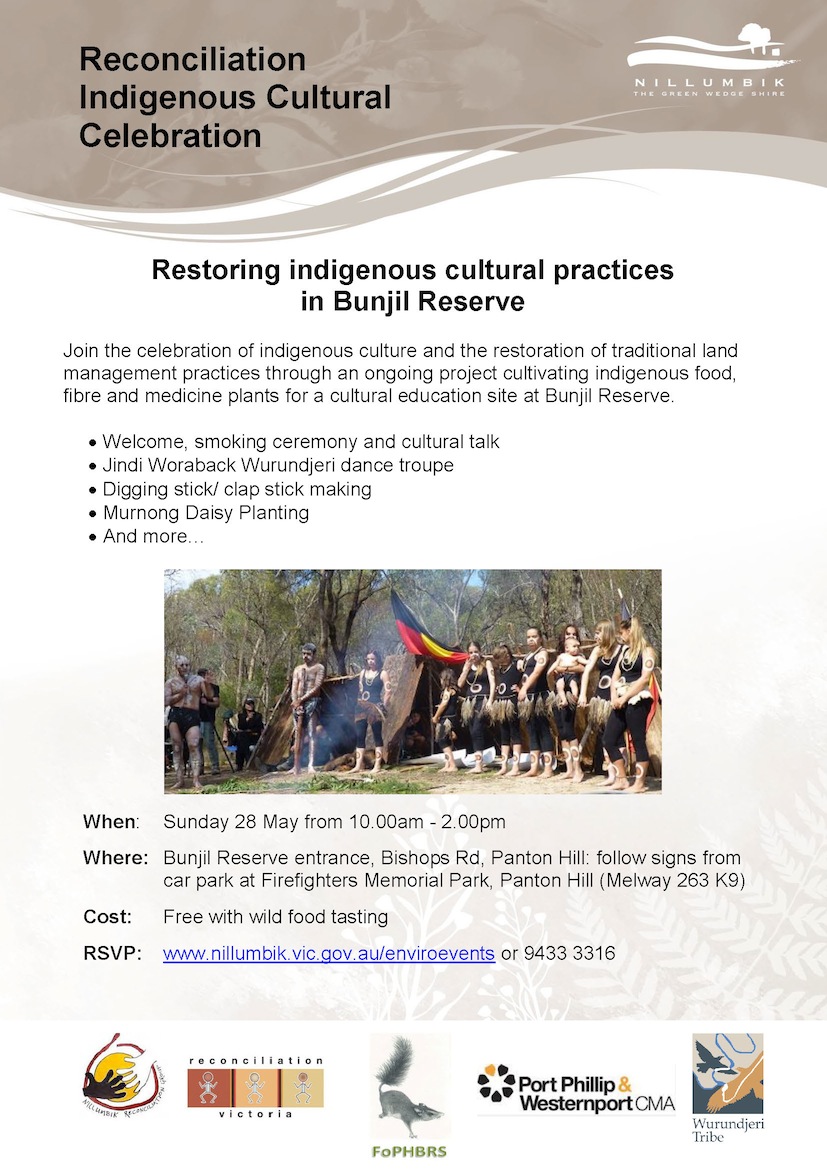
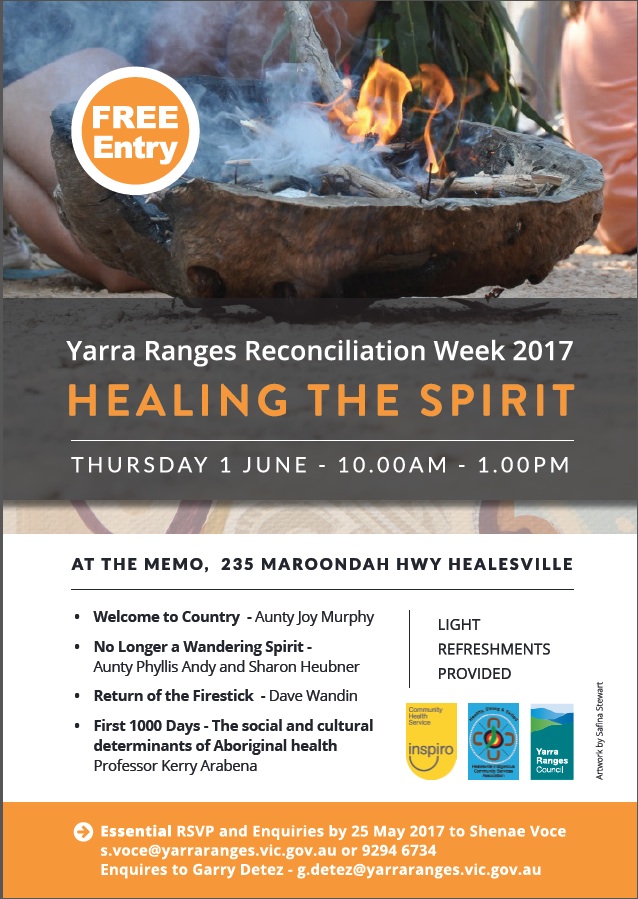
____________________________________________________________________

On 24th March the Nillumbik Reconciliation Group and Boite combined to present a most enjoyable concert in St. Margaret’s Anglican Church Eltham, featuring the Mission Songs Project by Jessie Lloyd.
The evening opened with an enthusiastic performance by the Mullum Mullum Choir.
Then Jessie followed with songs that reflected the musical style of the different locations where she had collected each one, and the words reflected the issues faced by Aboriginal people from that community. The songs were filled with hope, humour and sadness, but overall the resilience of Aboriginal people shone through.
The performance by her group received a standing ovation.
Diana Warrell
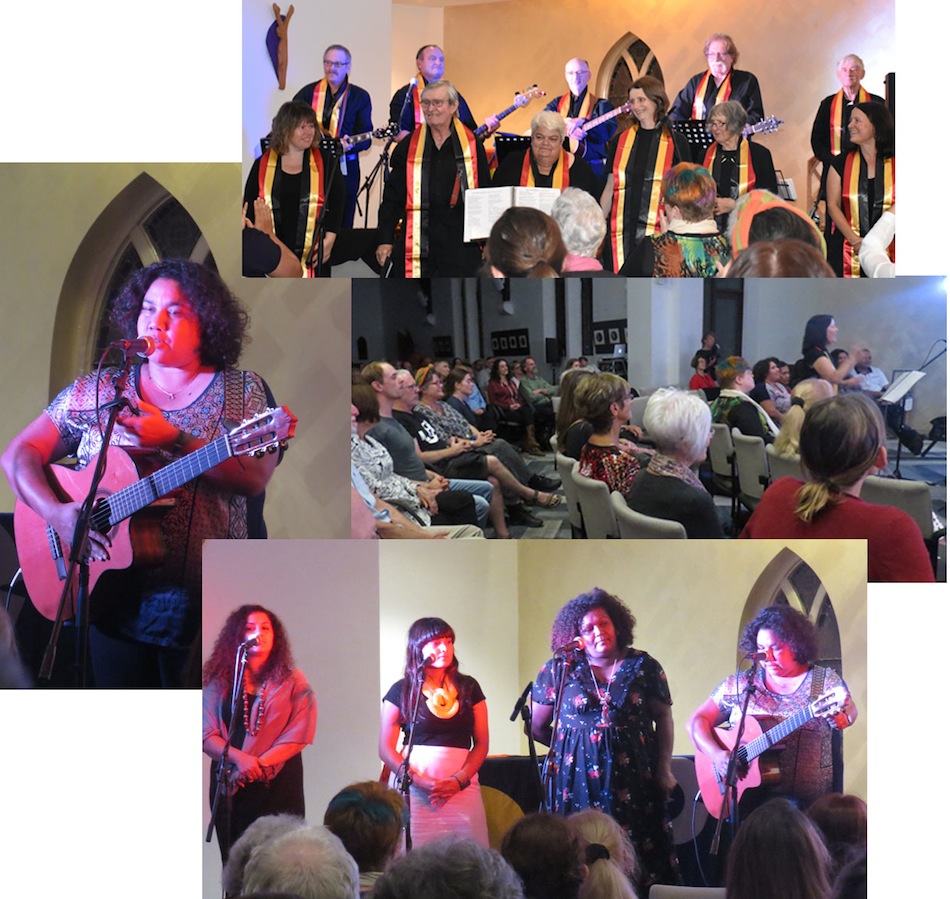
____________________________________________________________________
Moor-rul Reconciliation Grasslands
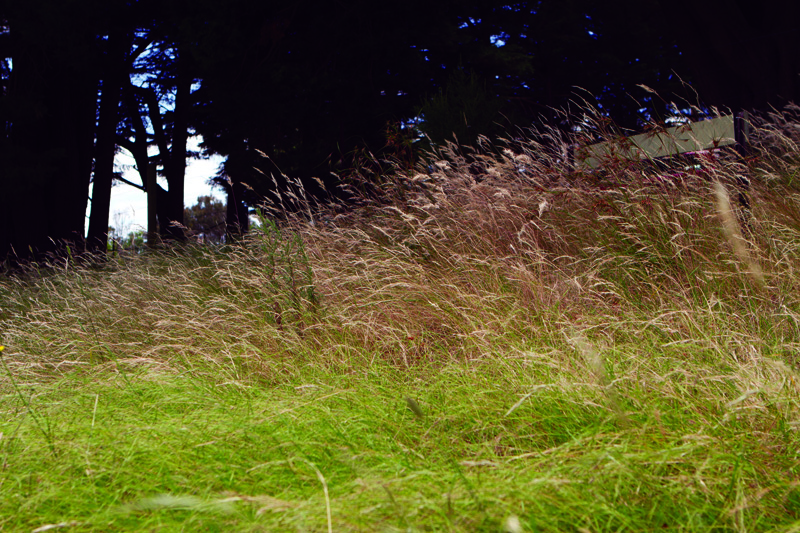
Photo: Naomi Mutch
The Moor-rul Grasslands were established in 2009 by the Nillumbik Reconciliation Group to regenerate a typical native grassland on a small area of basalt soil. It is one of two remaining grassland areas in the Shire of Nillumbik. The Grasslands are located next to the Kangaroo Ground War Memorial Tower and adjacent to the Kangaroo Ground lookout.
Grasslands provided an important source of food for local Wurundjeri clans.
- Grasses such as kangaroo grass themeda, wallaby grass danthonia and microlena were grazed by kangaroos, an easy target for hunters.
- Tubers from yam daisy Micrcoseries lanceolata, chocolate lilies Dichopogon strictus and orchids provided starchy paste and breads.
- Frogs, lizards and small marsupials were found among the grasses and small plants.
- Dry grass was used to draft-proof willams (shelters).
- Lomandra provided material for weaving baskets and carry bags.
Early rehabilitation included the erection of a rabbit proof fence to prevent rabbits from eating new growth and allowing seed to germinate.
The regeneration is achieved by removal of weeds which allows the native grasses and forbs to seed, and by planting appropriate species amongst the grasses. Traditional mosaic burning is also utilised to reduce weeds and encourage fresh indigenous growth.
FRIENDS OF MOOR-RUL GRASSLANDS
The Friends of Moor-rul Grasslands, part of the Nillumbik Reconciliation Group, was formed to coordinate the regeneration as a memorial to the people who used this land for hunting in former times.
Grasslands maintenance also has the support of Nillumbik Shire's Environmental Works Department.
Regular working bees, involving light weeding and planting, take place on the first Sunday of each month from 10:00 to 11:30am. (The next working bee has been rescheduled to 9th October.)
For further information please contact the Friends Group Convenor, Jann Darvill, on 9439 7342
or NRG President, Jan Aitken, on 9439 0342
____________________________________________________________________
ADDRESS BY JAN AITKEN TO THE ROTARY OF ELTHAM
NAIDOC WEEK, July 2016
I am very pleased to be here and thank you for inviting me to speak about Reconciliation in Nillumbik in honour of NAIDOC. This is a week when Aboriginal history, culture and achievements are celebrated.
Before we go further we must pause and make our acknowledgement.
We acknowledge the Wurundjeri as the traditional custodians of the land on which we meet and pay our respect to their elders, past and present.
When Aboriginal people visit the land of another Aboriginal nation they always acknowledge the traditional owners of that land. The owners of the land give a Welcome to Country, a Tanderum in Woiwurrung, the language of the Wurundjeri. Now when you are at an event and a Wurundjeri member gives a Welcome to Country or a Smoking Ceremony you can recognise that this is the act of a living culture. Adapted for today's conditions but having an ancient heritage. We make an Acknowledgement which reminds us that we are on Aboriginal land, that the traditional owners of this land are present and with us. We are not in Terra Nullius.
Their generous and gracious welcoming leads us to Acknowledge them.
You will be familiar with this now widely used Acknowledgement. It has been criticised as being a parroted statement with no meaning. So it is important that we say it sincerely and know about whom we are speaking. It is made at all Nillumbik Council meetings and Council events and was part of an agreement made by the Council in 1998. The Council delegated an advisory committee to arrange a ceremony promoting reconciliation. A formal document of Acknowledgement, Apology and Commitment was presented by the Council to Wurundjeri elders at a Gayip (Woiwurrung word for an inter-clan gathering) in May, 1998 in Wingrove Park. It was out of this that the Nillumbik Reconciliation Group emerged, first as an advisory committee for the Shire and later as an independent community group. In 2008 the Shire consulted with Wurundjeri people and with NRG and other interested parties to write a Reconciliation Charter which was passed by council. This requires all Shire departments to consider Aboriginal heritage in all projects undertaken. It requires the shire to continue making their Acknowledgement at all Shire meetings and events. And to support Reconciliation activities in the Shire. The Aboriginal Flag is flown alongside the Australian flag.
What does NRG aim to do?
- to promote reconciliation with Wurundjeri people,
- to celebrate Wurundjeri heritage in the Shire of Nillumbik,
- to know of resources which schools and community groups can use when they want to include Wurundjeri knowledge and reconciliation in their activities,
- to work with RecVic and ANTaR and other Reconciliation groups which are concerned with justice for Indigenous people in Victoria and Australia which is leading towards Constitutional Recognition,
- to support, through partnerships, reconciliation activities and events which other community groups arrange.
We are most fortunate to have as our patron, one of the founders of NRG, Mick Woiwod, local historian and a resource for Wurundjeri history whom the Wurundjeri people themselves value and use. Wurundjeri people have lost much of the Woiwurrung language and a great deal of their history and cultural knowledge through settlement of their lands and dispossession. But there is a very purposeful education of Elders and their youth by the Wurundjeri and people like Mick are an important source of information. Mick has published numbers of books which are significant resources about Wurundjeri culture and life pre settlement. Mick researches the discoveries of the people who had first contact with the Aboriginal people and their land. His published data bases are a superb record of these documents. The NRG also has a CD called the Wurundjeri Resource Kit which is in much demand from schools and people who live on Wurundjeri land. ($20 ) Mandy Nicholson, a Wurundjeri woman, is researching Woiwurrung language, building up vocabulary, working out grammar. She uses it when her dance group performs and tries to remember to use certain greetings and commands at home too so that the sounds become familiar. We are planning a language workshop with her for September.
The Wurundjeri Tribe Council is a contact point for members of the Wurundjeri community. It is the public presence for this clan of the Kulin nation dealing with government as needed. It provides a resource to those wanting Wurundjeri welcome ceremony, dancing and didg playing as well as being a contact point for permission for Wurundjeri place names, memorials etc.
Where are the Wurundjeri today?
The last census revealed that there are approximately 120 people living in Nillumbik who identify as of Aboriginal descent. Due to the history of dispossession few of these would be Wurundjeri people. They come from a wide range of Aboriginal nations.
During the years 1862-1923 there was an Aboriginal Reserve near Healesville called Coranderrk. During the 19th Century this 4000 acres on Badger Creek was a vibrant and successful community of Aboriginal people from Victoria who ran a profitable hops farm and provided meat and vegetables and fruit for self sufficiency. William Barak a Wurundjeri man was the last significant leader of these people often referred to as the Yarra Yarra tribe since they were from many areas of Victoria. However into 20th century the growth of agriculture in the Healesville area meant that the Aboriginal Reserve land was sought by settlers. In spite of William Barak's urgent and heroic work to save this land for his people the reserve was closed in 1923 and the Aboriginal people were sent to Lake Tyers. Today there is a significant population of Wurundjeri people in Healesville, many of whom are descendants of William Barak and other residents from Coranderrk. A four acre property and the manager's house remain in Wurundjeri hands with the Wandin family who some genertions ago lived on Coranderrk. Joy Murphy Wandin and her sister Doreen have taken a leading role in Wurundjeri dealings with government and shires.
We are all familiar with the idea that land has a special meaning for Aboriginal Australians. Aboriginal beliefs and culture connect them to the land of their tribe. They spring from the land, a physical and spiritual emerging from it so that they have a oneness with it. It is different from our love of the land, strong and spiritual as it is. Uncle Bill Nicholson says I love being out in this country. I do anything to get here and feel totally renewed in myself as Wurundjeri man.
Urban Aboriginal people have a painful issue of not having access to their lands. I was made very aware of this at a meeting which Jenny Macklin held for Nova Peris soon after Nova joined the NT Parliament. At question time a young Aboriginal mother stood and with considerable passion and anger told Nova that it was all right for her. She could go to the lands of which she was a traditional owner whenever she wanted to. But not for this woman. Every morning she said, she told her young son to go outside and put his foot on the ground because that is your land. It was a very uncomfortable moment. I am one of those who have descended from the occupiers who took this land and settled it. I know I have a legal title to my patch. But this woman was speaking of some quality of ownership which was far more than a title. Her passion was a window into Aboriginal pain and dilemma, if I could bear to listen and take it in.
NRG has some events which happen every year along with different projects which are
the inspiration for a specific year.
Flag Raisings: On Australia Day as the first act of the Citizenship ceremony we organise a flag raising. To this we invite an Indigenous didg player and an Aboriginal speaker. When the British flag was raised at Port Jackson, Captain Phillip knew the Aboriginal inhabitants were there but did not consider them as sovereign people. So in the spirit of Reconciliation today, they are part of this ceremony and new citizens have an opportunity to hear an Aboriginal person speak. That is something which many of us have not experienced. There are a good many opportunities in Melbourne but you need to look for them. It is something we are currently organising for Eltham.
We also organise with the Shire a flag Raising at the Shire Offices during Reconciliation Week which starts on 26 May each year. At this flag raising we invite schools to participate by sending student representatives. Some of those schools make statements about the importance of Reconciliation: coming together, knowing the true history, legislative change, saying sorry for taking the children from their families, recognising they were here a long time before we were (mosaic with 3000 black pebbles for the generations of Black people and 10 white pebbles for us), the difficulty of the date of Australia Day. Very thoughtful statements. Generated by the teachers of units dedicated to teaching Indigenous history and Reconciliation today.
They bring reconciliation posters which are displayed by arrangement with Eltham Library. One of these posters is on view for you to see.
Following on from discussion with Eltham High School Captains about Reconciliation Week an Aboriginal theme for a whole school assembly of 1400 students was organised by the school captains with Brooke Wandin, Wurundjeri woman speaking and Mandy Nicholson and her Djirri Djirri Dancers performing. NRG helped with funding for this event and were invited to attend.
The GAWA Trail is a flat 350 metre trail through riparian bush near the Watsons Creek on the Etham Yarra Glen road. Easy to find as it is about a kilometre along the road from the Watsons Creek Café and Antique Store. If you haven't walked it yet I commend it to you. Along this trail we have placed information plaques. Judy Nicholson, a Wurundjeri artist designed the frame for the information which tells about the uses to which Wurundjeri people put the plants and animals found on this reserve. We worked with Wurundjeri Elder Bill Nicholson, Mick Woiwod, Environmental staff from the Shire. We researched the information and found photos for these plaques. It was a project which took about 2 years to complete. Maintenance is done by the NRG members with assistance as needed by the Shire environmental works. We take school groups around the trail and encourage people to visit it and learn from the plaques in a self guided tour. Brochures.
We have a small area of grassland near the Kangaroo Ground Tower which we have been regenerating into indigenous grassland for the last 5 years. We weed out the pasture grasses and plants up with Indigenous grasses and forbs remembering that this area was famous grassland which fed many kangaroos, important food source for Wurundjeri people pre settlement.
NRG also has a website and a large mailing list for e-mail information about events with Indigenous themes. You can request to be on this and if you feel inspired to become a paid up member for $10 we are very pleased as it assists our authenticity as an Incorporated organisation. Membership forms available.
There are Reconciliation activities by other community groups in Nillumbik:
- Child Care Centres have been introducing Aboriginal plantings, art works and stories .
- A group of residents from Christmas Hills has organised an Aboriginal Writers Festival for April next year to be held in the refurbished hall there.
- Oxfam partnered with NRG and invited Shane Charles to speak about Aboriginal issues in Victoria in April.
- Amnesty International at Eltham has had discussion about indigenous issues and works promoting human rights for Aboriginal people living under the legislation of the Intervention.
- NRG has been invited to meet with the Nillumbik Heritage Group so that indigenous history and culture can be included in historical deliberations.
- Montsalvat with NRG partnership has taken on the Past Matters Festival of Aboriginal Writing and Culture originally held for 0ver 10 years by Meera Govil at Eltham Bookshop with whom NRG still partners for Indigenous authors.
- And tonight we have Eltham Rotary listening and thinking about Reconciliation and what it means for us here in Nillumbik.
The Shire has always been generous in its funding provision for our projects. But now,
Reconciliation in Nillumbik is very much a shared responsibility with the Shire. The
Nillumbik Shire Council Charter (2008) has gradually come into action. Over the last
three years Environmental Works under leadership of Brad Tadday have been making
great moves in working with Wurundjeri Elders Uncle Dave Wandin and Uncle Bill
Nicholson in restoring the Panton Hill Reserves using the Narrap Team.
Led by Uncle Dave this team of Wurundjeri men work on environmental projects. Wurundjeri country extends over the Yarra River Valley so for these men, many of whom live in Healesville area working on their traditional land gives strength and meaning . And for significant times such as Reconciliation Week the Shire has arranged events at which Wurundjeri dancers and Elders can smoke us and give Welcome to Country.
Did you know that Eltham is the site of an ancient eel trap on the Yarra? That the old property of Morrisons on Laughing Waters Road is now maintained as a Wurundjeri precinct. Three trees have been carved with designs of cultural significance by three families of Wurundjeri descent: Wandin, Terrick and Hunter. To attend events at which the Wurundjeri themselves celebrate their land gives a very special life to the land of Nillumbik. A gift to us from Wurundjeri who continue to include all residents of Nillumbik and neighbouring shires in their celebrations of Country and their own culture and survival.
There has been a war of words and many fears of territoriality as Aboriginal sovereignty has become more vocal. As Aboriginal people have became more vocal and activist Reconciliation hovers between the relative safety of recognition and preservation of heritage and the more difficult calls for Constitutional recognition and for a treaty or perhaps treaties in acknowledgement that there were a couple of hundred Aboriginal nations in Australia all with their own pain and needs for a recognising relationship with the occupiers of their land..
Reconciliation is thinking its way through a minefield of confusing notions. The myth of Terra Nullius has been discharged and we are now faced with what to do . How can we acknowledge that Aboriginal people are the first Nations, the original owners of this land without acknowledging the truth of the foundations of our nation. Thinking of the implications of this truth is painful and challenging. What do we do if we own that we are occupiers and dispossessors? We cannot undo history just as we cannot undo our own histories much as we might like to at times. How do we meet the original inhabitants as sovereign people?
In Victoria this year something new is happening in Reconciliation. A first in Australia. We have all heard that there is a proposal to change references to racist laws and to include recognition of Aboriginal people as the first nations in the constitution. The difficulty of having a successful referendum and the problematic wording of a referendum question have bogged the project in promises with no conclusive action to date. However many Aboriginal leaders do not feel that these altered constitutional articles will really make much difference to their status and place in the Australian nation. It is something that white people are offering them so it is more about us than really meeting Aboriginal nations as sovereign peoples with a voice of their own. Some months ago 800 Aboriginal leaders from all tribes and groups in the state met in regional four centres to discuss what they wanted: They were all clear. They did not want constitutional change. They wanted a treaty. They then met for two days with government in Melbourne and there a tentative agreement was reached on a process which could lead to a treaty between Victoria and the Aboriginal Nations from our state. They have appointed a steering committee and will meet again with the government in 6 months time with proposals for discussion and negotiation. In the past suggestions of a treaty have been reacted to with horror, fear, and retreat because it all seemed too difficult and impossible and threatening. Now the Victorian Government is listening and meeting with these leaders and the Aboriginal thinkers for the time are thinking and speaking and the possibility of a treaty which names, recognises and speaks the truth is being negotiated and worked on. The Aboriginal nations are having to work together to formulate the terms of a treaty which will honour them and establish the parameters for working relationships between all parties to it. It may be one treaty, it may be 39 treaties, one for each of the 39 Victorian Aboriginal nations. But it is being worked on. This is the new face of Reconciliation. What is different is that Aboriginal people here have taken the initiative to work with the government on this. It is not a handout of funds or a government inspired project of help. It is an Aboriginal initiative. They are being taken seriously and are having to meet the challenge of a developing something which all clans and tribes agree on. ? Impossible? May be, may be not. It is being pursued and has gone further than imagined even at this stage.
This IS Reconciliation in our state in 2016. I think it has reached this possibility because of the work of reconciliation which each shire in Victoria has practiced through the activities of the reconciliation groups of which NRG is one. Groundwork is on- going; relationships with Wurundjeri people are established and there is a working together with respectful recognition. And of course, one of the most significant aspects of the Reconciliation movement is work in schools. Hearing our youth speak of their convictions and openness to meeting Aboriginal people with moral and ethical intentions of justice, recognition and compassion is heart warming and salutary and holds the hope for the future for Australia.
The next thing is for us to be hearing from Aboriginal people themselves. NRG is working to make this possible in this Shire over the next year.
____________________________________________________________________
Restoring Indigenous Cultural Practices
in Bunjil Reserve
The Shire of Nillumbik, Nillumbik Reconciliation Group,
Wurundjeri Tribe Council and Friends of Panton Hill Reserve
joined together to celebrate Reconciliation week at the Bunjil
Reserve on Sunday 29 May 2016.
Recently, Brad Tadday from Environmental Works at the Shire
had organised the Narrap Team under Uncle Dave Wandin to clear
woody weeds. Volunteers then gathered the cut branches, stacking
them near an entrance for mulching. Now there are clear paths and
a pleasant green meeting place. It was here that we all met.
Mayor Bronnie Hattam gave the Council Acknowledgement and
spoke of the importance of linking Nillumbik with its Aboriginal
history and heritage. Then came a Smoking Ceremony with Uncle
Dave, followed by dances with the Djirri Djirri Dance Group with
Mandy Nicholson and Darren on didg, all under the management of
MC Paul Byrne-Moroney.
After lunch of barbecued emu and croc sausages prepared by the
Diamond Creek Men's Shed we had a choice of Yam Daisy planting
with Uncle Dave, weaving lomandra with Brooke Collins,
Wurundjeri woman, and working on a Bunjil's Nest.
NRG supports the work of Brad Tadday and the Shire of Nillumbik
in these important acts of Reconciliation and Recognition.
We thank them for the opportunity it gives members of Nillumbik
Shire to share with Wurundjeri people a love of the land which has
been theirs for thousands of years.
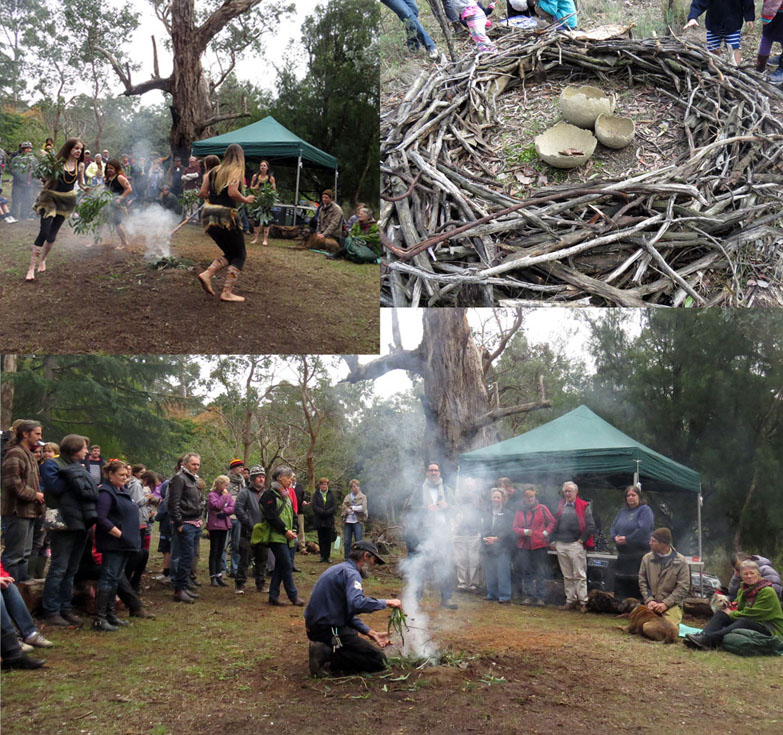
Photos: Diana Warrell
**********************************
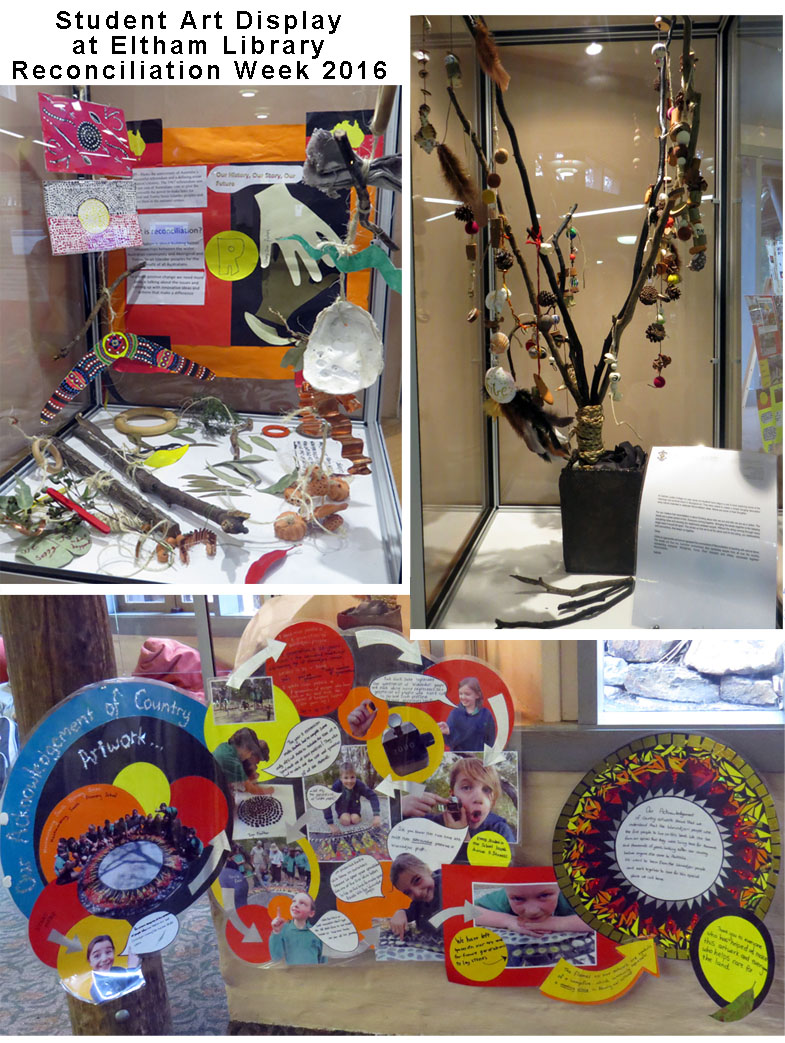
Photos: Diana Warrell
____________________________________________________________________
Australia Day 2016 Flag Raising in Nillumbik
The Nillumbik Reconciliation Group supported by the Nillumbik Shire Council held a Flag Raising to start the Australia Day Citizenship ceremony.
Our Indigenous representative was John Baxter who gave a stirring speech about the welfare of Aboriginal people today.
He raised the Indigenous Flag with the assistance of Perry Wandin (Wurundjeri Elder) and was watched by the large crowd who then entered the Nillumbik Community Centre to continue the Australia Day Citizenship ceremony.

____________________________________________________________________
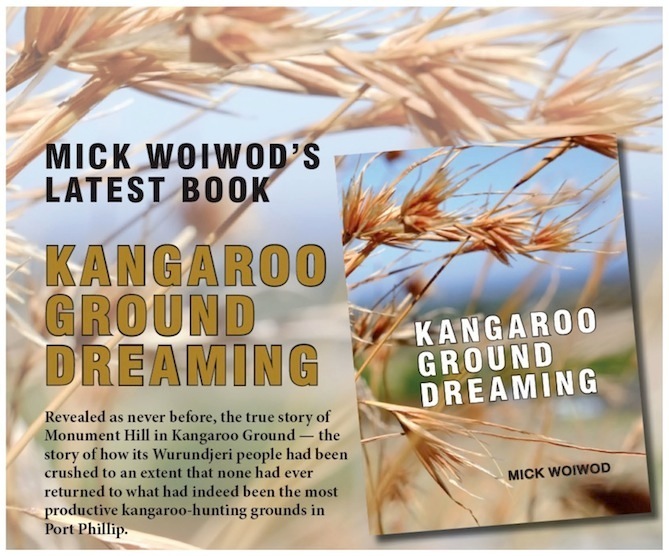
Copies of Kangaroo Ground Dreaming can be purchased from
Eltham Bookshop, Main Road, Eltham
or send
an email to Mick.
______________________________________________________________________
.jpg)
The new Gawa markers are in place for an enhanced self-guided tour.
Click here for the Gawa Wurundjeri Resource Trail page.
You can see the new Gawa plaques here (large file: 3.5MB)
Find it here: 873 Eltham-Yarra Glen Road, Watsons Creek (Melway 272 D4)
Click here to read about the launch event.
______________________________________________________________________
NRG is now on Facebook - click here
______________________________________________________________________
THE WURUNDJERI
THE KULIN NATION consisted of the Woiwurrung, Bunurong, Wathaurong, Taungurong, and Dja Dja Wurrung language groups. These were the clans who’d once lived in the Yarra Valley, the City of Melbourne and the country around Kilmore, Geelong and the Mornington Peninsula. The Wurundjeri-willam spoke Woiwurrung. Their lands extended from Heidelberg to Mt Baw Baw.
A clan consisted of about 50 individuals of different generations. There were two moieties, Bunjil (Eaglehawk) and Waa (Crow). Through the system of skin groups and moieties there were strict rules for marriages. In this way the genetic pool remained strong.
All Aboriginal people were competent linguists. Knowledge of language was important for trading and the settling of disputes between the various clans. Marriage partners had to be won from a clan speaking a different language. When white settlers arrived the Wurundjeri were easily able to pick up English and use it whilst the settler world had found Aboriginal language far more difficult to learn.
All clan members knew their land intimately. They knew the best time to visit particular areas for weather protection and food resources. In winter when the rivers flooded they’d camp in higher country. Spring and Early Summer were times of movement, with yams ready for harvesting, bird's eggs abundant, wildfowl and animals plentiful. Only what was really necessary was taken - the harvesting of plants, roots and tubers would be undertaken at a time when their regrowth was assured.
In Early Autumn eels and fish attracted the clans to sites near creeks, rivers and billabongs where the clan could camp for longer and participate in corroborees with neighbouring clans. It was at this time of year that disputes were settled, punishment inflicted, stories told, dances performed and marriages arranged. People were not permitted to marry within their own clan so partners had to be chosen from other Kulin clans.
For more information on how the Wurundjeri followed the seasons, see Beth Gott's "Seasonal Calendar for the Melbourne Area": http://www.herringisland.org/seasons1.htm
The Wurundjeri made tools from stone, bone, bark and wood. They had no metal or glass until settlers arrived in the 1830s, and they adopted the new materials for utensils, tools and weapons, including guns and knives.
Like all Aboriginal people, the Wurundjerihad been able to supplement the products of their land by trading with others. The Greenstone which the Wurundjerihad once mined on Mt William, near Kilmore, was traded by them as it was sought after for axe heads. Greenstone has since been found as far afield as Queensland.
Fire could be easily produced by rapidly twirling a short length of a Coranderrk wand with a flower-stalk of a grasstree. This would have resulted in trade with neighbouring clans who lived in areas where grass trees flourished.
Archaeologists have found that whilst the early Aboriginal immigrants to Australia had been hunter-gatherers, they’d later developed more sedentary ways by harvesting eels and cultivating murrnong (also known as Yam daisy), by the development of grasslands through firestick-farming and the harvesting of Bogong moths in the high country. All of these developments had seen food resources become more reliable. It is well documented that more children are born and successfully nurtured when there is adequate food to raise them.
Each region in Australia had been developed differently in response to available resources. There had therefore been great diversity, complexity and intensification in the use of resources in the two thousand years before white settlement.
‘Where might this have led Aboriginal people if the First Fleet boats hadn’t sailed into Port Jackson in 1788?’
______________________________________________________________________
A Short-lived Reserve
The Chief Aboriginal Protector, George Augustus Robinson fought to secure land for the Wurundjeri people, noting in his diary on May 3rd 1839:
‘Had a long conversation with surveyor Mr. Hoddle. Showed me a map of the county, marked off into allotments comprising I think fully 30 square miles and not a single reserve for the blacks except the mission which I have no wish to retain. I said if that or a similar map was exhibited to the people of England they would at once see the way the natives are treated. Their lands sold from them and no provision made for their maintenance, and this by the government who are bound to protect them.’
It took until 1852 for a 1908 acre Aboriginal Reserve to be formally set aside at Pound Bend. However, gold had been discovered at Warrandyte in 1851 and the Reserve’s future was doomed. The Wurundjeri knew this and decided to hold one last corroboree. The Aboriginal Protector William Thomas described the event held in March 1852 as follows:
‘They had not met for many years and wanted to have once more some corroboree together….and night after night for fourteen days they did indulge themselves.’
However after the corroboree some of the Wurundjeri decided to go on one last walkabout to Melbourne. Not having permission to leave the reserve they were arrested at Bulleen and sent to the Police Paddocks at Dandenong. Others continued to live on creek-side encampments or work on local stations, while others moved to the safety of the Upper Goulburn until land was reserved for them at Coranderrk in 1863. Pound Bend served as a ration station until closed in 1862.
Nillumbik Reconciliation Group, in partnership with Reconciliation Manningham, has erected plaques on two boundaries of the former reserve: at the confluences of Stony Creek and of Anderson Creek with the Yarra River. The plaques were unveiled on 23rd March during the Warrandyte Festival.
You can download a flyer with more information and directions to the sites here.
More extensive information on the plaques, historical notes on the Wurundjeri of the Yarra Valley, and sites of significance around Melbourne are included on a brochure that can be downloaded here.
.jpg)

Auntie Di Kerr speaking at the plaque unveiling. Photo: Diana Warrell
______________________________________________________________________
2012 Victorian Community History Awards
Mick Woiwod's Coranderrk Database has received a Victorian Community History Award under the Local History Project category. The awards are given by the Royal Victorian Historical Society and Public Record Office Victoria. This award “recognises activities that enhance access to records of significance to local communities. The project should increase access, awareness and participation in history on a local or community level, including digitising, indexing, cataloguing, resources and original research.”
The citation reads as follows: “Woiwod’s research makes this much more than a compilation. It is a resource kit providing detailed material presented chronologically about Indigenous people at the Coranderrk Aboriginal station near Healesville, designed to serve communities in the Yarra Valley and Victoria generally through libraries. It represents a huge effort in collection, arrangement and interpretation and deserves to be widely used. It also presents new material about the well-known story of Coranderrk’s demise.”
Congratulations to Mick, and thanks for all his work – his knowledge of Wurundjeri history is invaluable.
A booklet listing the awards can be downloaded here (620KB).


All copies of the original and second print runs have now been distributed.
Double-CD sets, containing the complete text in Word & pdf formats,
are available @ $30 per set (plus $5 postage).

For further information please contact the Secretary.
______________________________________________________________________
THE WURUNDJERI CULTURE RESOURCE KIT
IS NOW AVAILABLE ON DISC
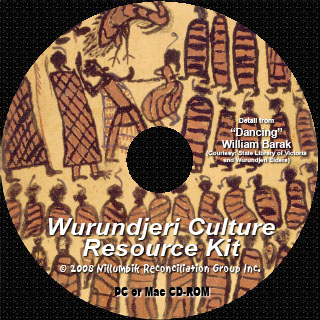

The Wurundjeri Culture Resource Kit has been completely updated and is now available on CD-ROM. (It's no longer available as a photocopied & bound hard copy because the CD format is far more useful, such as for printing multiple copies of the class exercises.)
The kit is primarily targeted at children in the primary years, and as the title implies it is particularly relevant to the Yarra Valley and surrounding areas – Wurundjeri country.
However, other regions would find much that is relevant, and would also see ways in which they would be able to particularise it to their areas.
You can download a preview of the first ten pages here (1MB pdf file). The CD-ROM includes files to print a board game up to A2 size.
The price of the kit is $20 (plus $5 postage).
Please contact the Secretary for further information.
__________________________________________________